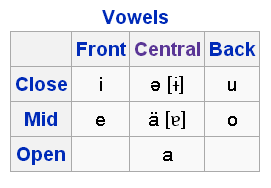In general, vowel backness (as well as all the other attributes) is not the property of a certain language. It's because of the nature of the human vocal tract.
This way, each vowel sound produced has a certain backness (as well as the other features).
However, languages use different mappings of phones to phonemes. In other words, each point on a vowel diagram is not a point, but rather an area. Everything that falls into that area is mapped to a certain phoneme.
There are plenty of languages that do not distinct backness (on IPA vowel diagram, it looks like an area occupying the whole width of the diagram).
For example:
Polish "mysz" (mouse) [mɘ̟ʂ]. Different speakers may actually say [mɪʂ] or [mʊʂ], but a listener would map it to an existing phoneme, ɘ̟.
German "bitte" (please) [ˈbɪ-tə]
Greek "ακακία" (acacia) [ɐ-kɐ-ˈci.-ɐ]
There is yet another consideration. Although some languages lack cardinal central vowels, those vowel appear in a spoken language due to various phonetic phenomenons (of course, individual for every language). For instance, it's a common effect of centralization/reduction of unstressed vowels in Russian:
"молоко" (milk) [mə-ɫʌ-'kɔ]
Note that this word contains three "o", the last one in stressed, and two unstressed ones are reduced in different ways.
"этот" (this) [ˈɛ-tət]
Note that ɛ (front mid) in this word, regardless of stress, is often pronounced ɜ (central mid).
